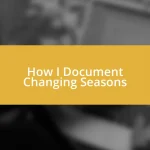Key takeaways:
- Urban landscape photography involves capturing both the architectural beauty and the human stories of a city, often highlighting details that reveal deeper narratives.
- Utilizing the right gear, experimenting with unique angles, and effectively using natural light are crucial for creating captivating urban images.
- Building a diverse and intentional portfolio, along with seeking feedback, helps in showcasing the emotional depth and varied experiences of urban life.

Understanding Urban Landscape Photography
Urban landscape photography captures the essence of city life, merging architectural beauty with human activity. I often find myself wandering through bustling streets, waiting for that perfect moment when light and shadow play together on a building’s facade. How often do we overlook the subtle details that tell a city’s story?
While shooting, I try to connect with my surroundings deeply. There was a day when I stood on a rooftop, mesmerized by the contrast between a serene sunset and the frenetic energy below; it struck me just how alive urban spaces can be. Isn’t it fascinating how a single photograph can encapsulate both the quiet solitude and the collective vibrancy of a city?
The challenge lies in finding the extraordinary within the ordinary. I remember taking a shot of a cracked sidewalk adorned with a single blooming flower. That image not only showcased resilience but also reminded me that beauty often thrives in unexpected places. Have you ever paused to appreciate something simple yet profound in your daily environment?

Choosing the Right Gear
When it comes to choosing the right gear for urban landscape photography, I believe that the tools you use can greatly influence your creative expression. My go-to camera is often a versatile mirrorless model; its lightweight body makes it easier to navigate crowded streets and capture spontaneous moments that urban life presents. I also find that carrying a solid tripod is essential, especially when shooting in low light situations, like the golden hour when the city begins to glow.
Here’s a quick list of gear I find indispensable for urban exploration:
– Camera: A mirrorless or DSLR with good image stabilization.
– Lenses: A wide-angle lens for sweeping cityscapes and a good zoom lens for details.
– Tripod: A lightweight, sturdy model for stability in diverse settings.
– Filters: ND filters help manage sunlight when shooting bright scenes.
– Extra Batteries and Memory Cards: Always handy for those long shooting days.
Once, while photographing an old building bathed in afternoon light, my battery died. It’s a rookie mistake I’ve learned to avoid, reminding me to always be prepared. I cherish those moments of spontaneity with my gear; each piece allows me to connect deeper with the lifeblood of the city, capturing not just the visuals but the very feelings they evoke.

Finding Unique Angles
Finding unique angles in urban landscape photography is an exhilarating process that often requires me to shift my perspective. I remember one afternoon in a crowded market where I crouched low to the ground, capturing the vibrant life bustling above. This change in viewpoint transformed an ordinary scene into a dynamic composition, emphasizing the energy of the crowd while showcasing the intricate details beneath their feet. Isn’t it amazing how a slight adjustment can not only tell a different story but also evoke a completely different emotion?
Sometimes, I find that the best angles are hidden in plain sight. Take, for instance, a time when I noticed the reflection of a striking skyscraper in a puddle after a rainstorm. Instead of shooting from eye level, I positioned my camera just above the water’s surface. This simple shift created a surreal image, merging the architectural lines with the sky’s soft hues. I often ask myself, what overlooked elements might add depth to my shots? Embracing my curiosity often reveals beautiful surprises waiting to be discovered.
Experimentation is key in finding unique angles. A trip to a city with winding alleyways challenged me to climb onto a ledge to frame a narrow street, capturing the juxtaposition of historic buildings with contemporary art. This elevated perspective allowed me to weave a story through my lens, highlighting contrasts in architecture and culture. Have you ever thought about how elevation can change your perception? I’ve learned that simply looking up—or down—can lead to extraordinary frames that truly encapsulate the essence of urban life.
| Experience | Angle Type |
|---|---|
| Crouching Low | Dynamic Perspective |
| Camera Above Water | Surreal Reflection |
| Climbing for Overview | Narrative Depth |

Utilizing Natural Light Effectively
Utilizing natural light effectively in urban landscape photography is something I’ve grown to appreciate deeply over the years. There’s a certain magic that happens when the sun dips below the horizon, bathing the city in warm, golden hues. I can’t help but think back to one evening when I was perched on a rooftop, camera in hand, as the skyline ignited with color. The interplay of light and shadow transformed mundane buildings into dramatic subjects, reminding me of how essential the right light is in crafting a captivating image.
Often, the best light appears when you least expect it. I recall a midday shoot where I almost packed up early, feeling defeated by harsh sunlight. Instead, I decided to wait for the moment when a cloud drifted in front of the sun, softening the brightness. That fleeting moment of diffused light resulted in a beautifully balanced shot of a busy street, where the shadows added depth to the scene. This experience taught me that patience is key; sometimes waiting for just the right light can unlock a world of possibilities.
I frequently remind myself to consider the time of day when planning my shoots. The “golden hour,” which occurs shortly after sunrise and before sunset, is my favorite. I remember a vibrant morning at a popular city park, where the soft light illuminated the dew on the grass and created dazzling reflections in the nearby pond. Capturing that serene moment felt like a gift, a reminder that light can evoke emotions just as strongly as the subject itself. When do you find yourself most inspired by natural light? For me, it’s those times that motivate me to explore a scene further and capture the city’s heartbeat.

Incorporating Human Elements
Incorporating human elements into urban landscape photography can truly elevate my images. I vividly recall a day spent in a bustling subway station, where I focused on capturing commuters amidst their daily rush. The stark contrast between the sleek architecture of the station and the candid emotions on the faces of the travelers created a narrative that resonated with me. Isn’t there something profound about capturing the lives of everyday people in the backdrop of a city’s infrastructure?
Sometimes, the fleeting moments catch my eye the most. Like the time I snapped a photo of a street performer engaging with a group of children, their laughter ringing throughout the area. This scene not only highlighted the vibrancy of urban life but also intertwined the playful innocence of youth with the city’s gritty textures. Can you feel the warmth of the laughter through the lens? This connection between human moments and urban landscapes adds layers to the story that my camera captures.
I’ve learned that including human elements can often breathe life into a static scene. On a recent shoot in a vibrant neighborhood, I photographed a local artist painting a mural on a weathered wall, surrounded by curious onlookers. This not only showcased the artistry but illustrated the community’s interaction with urban space. It made me reflect on how cities are, at their core, a collection of shared experiences and stories. What conversations do you think these images would spark in the viewer’s mind? For me, they ignite a desire to explore the narratives that unfold in every corner of the city.

Editing Tips for Urban Scenes
Editing urban scenes is where an image can truly transform and come to life. I often find that adjusting contrast and saturation can help highlight the vibrancy of city life. For example, when I edited a photo of a bustling street fair, increasing the saturation made the colorful tents and cheerful faces pop, instantly drawing the viewer’s eye. Have you ever felt a photo fall flat until the colors got a little boost?
Another key aspect for me is cropping. Sometimes, less is more. I remember working on a skyline image where the initial composition felt cluttered. By cropping out unnecessary elements, I managed to focus on the stunning architecture and create an effortless flow across the frame. This taught me to look closely at my work – what can I remove to amplify the subject’s impact?
I also love to experiment with filters and presets, but judiciously. I recall one particular night in the city when I applied a slight vintage effect to a photo of neon lights reflecting in puddles. This added a layer of nostalgia, making the scene feel like a memory rather than just a photograph. There’s something intriguing about how an edit can evoke feelings or tell a different story entirely. What stories do your edits want to convey?

Building a Portfolio of Work
Building a portfolio of urban landscape photography is a process that requires intentionality and a lot of reflection. I remember the first time I curated my collection; I found myself looking back at over a hundred images and having to decide which ones truly spoke to me. It was a tough decision. Each photograph had its own story, but the ones that resonated were those that captured not only the architecture, but also the emotion of the environment. Do you ever feel like some images just resonate more than others?
As I refined my portfolio, I learned the value of diversity. My early collection was heavily focused on skyscrapers and street scenes, but I realized I needed to showcase the different moods of a city. A chilly winter morning with frosted sidewalks feels completely different from a vibrant summer festival, right? I included images from each season to highlight the dynamic nature of urban life – from quiet, reflective spaces to bustling, energetic gatherings. This evolution taught me to embrace that contrast, making my work much more engaging.
Moreover, seeking feedback from fellow photographers was invaluable. I recall a constructive critique session where peers pointed out the emotional impact of my images. It was eye-opening to see my work through different eyes and gain insights into what resonated with others. Have you considered how feedback can shape your perspective on your own work? It illuminated for me the importance of a well-rounded portfolio, where each image not only stands alone but also contributes to the overarching narrative I want to tell about urban landscapes.












